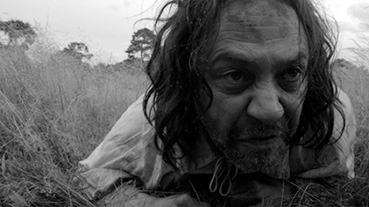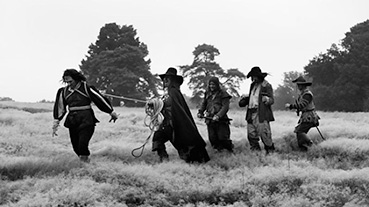Michael Ewins is a regular contributor to Cine Outsider. This article originally appeared on E-Film Blog July 5th 2013
Against the ravenous precipices and turbid waters of the Orinoco river, whose immensity stretches toward oblivion, the solider Aguirre's (Klaus Kinski) gorgonic features engulf the frame. He turns, his bulging eyes dissolving the fourth wall, perhaps suggesting that no such thing even existed; it has only ever been he and the tide fighting against time itself. This indelible image belongs to Werner Herzog's Aguirre, The Wrath Of God an unmistakable (though unacknowledged) influence on Ben Wheatley's latest, a mythic black-and-white, Civil War-era folk story set in the Godless English countryside.
In the former film, a disorganized expedition descended upon the Amazon in search of El Dorado, a lost city of gold; the journey undertaken in A Field In England, by a gander of deserters, is by contrast less noble – they wander blindly toward a rumoured alehouse. But they are in fact the same, led by deluded men in search of riches and dreaming of powers greater than those they possess, lost in an unforgiving landscape, which, no matter how far they travel, is never more than the same stretch of land which came before it. Aguirre becomes theatre in its third act, with the conquistador's raft transformed into a makeshift stage, cast against a perpetual backdrop. A Field In England adopts no central object as its own stage, but as the film unfurls it becomes increasingly more confined, limited to a space where Wheatley's camera can crawl up to his character's faces, forcing their gaze toward ours.

Both films deliberately avoid establishing or measuring space in any geographical sense, and just as Aguirre may be drifting in circles, the cowardly Whitehead (Reece Shearsmith) ends the film in the spot where he began, crawling back into the bushes and thickets from which he escaped, in the same POV shot. Landscapes flatten and overwhelm; in each film they are as empty as they are vast, and inhabited only by enemies (the native Indians in Aguirre, the rival English in A Field; in each case the so-called enemy exist on their own turf). The films are metaphysical and surreal, though Wheatley's in a more obvious way – the hallucinogenic sequences in his film are strikingly avant-garde, using strobe effects in a manner so aggressive that you could mistake them for Gaspar Noé's. And this film has a shot similar to the first mentioned in Aguirre, where the leader O'Neill (Michael Smiley) turns toward camera, his piercing eyes meeting ours; just one way in which Wheatley breaks his fourth wall, sometimes stopping for tableaus like old monochrome photographs or, again, theatre.
Another, more contemporary influence could be Meek's Cutoff Kelly Reichardt's 2010 Western set on the Oregon trail. Again we find a leader (Bruce Greenwood) as lost as his followers, delusional, adrift in an unforgiving landscape which seems not to evolve. In all three films it is impossible to tell in which direction the characters have come from or are going, and we do not meet them at the beginning of their journey, nor see them to its end. These are stories within stories, where we are left to imagine what has come before and inevitably what will come after. There is a sense of abandonment, loneliness, Godlessness (in Aguirre literally, as the priest reveals himself as a two-faced opportunist and coward, and Aguirre declares himself "the wrath of God").

In Meek's Cutoff and A Field In England, there is a moment when the insidiously slow pacing moves from trot to canter, breaking from its established rhythm for a set-piece which will change the course of the action. The characters involved (those who cause the incident and those who adopt power), are almost the same, albeit taking into account the context of each story, within its genre. Wheatley's film is a formidable and beautiful creation, strongly reminiscent of a vein of English filmmaking which includes Culloden (Peter Watkins, 1964) and The Witchfinder General (Michael Reeves, 1968), though O'Neill's hat I think purposefully resembles The Alchemist's in Jodorowsky's The Holy Mountain. Such cult bizzaro points of reference make Field that much more of a unique and challenging prospect in today's cinema. In the way that it moves and feels, and the specificity of its performances, there is nothing else like it. But might it be enriched if considered in the same breath as the aforementioned titles, which have a common theme, sense of place certain character types, and unravel at a similar pace?
|